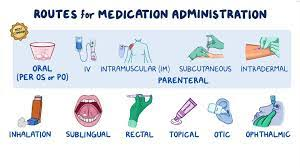In hospitals, nurses and doctors have options to administer medication to patients. The choice of administration method depends on factors like the drugs chemical properties, desired response and patient demographics. Medications can be given orally, through injections or topically.
Oral medications are commonly used because they are simple and easy to use. They usually come in tablet form with sizes, shapes and variations like sugar free, liquid or chewable. Some tablets have the active ingredients mixed with a liquid to make swallowing easier. Others have a coating that only dissolves when the tablet is broken or crushed. This coating can be in the form of a gel, solution or syrup.
Injections are another way of administering medications. The injection is usually given into a muscle such as the arm, thigh or buttock beneath the skin and fat tissue. This method is preferred when larger volumes of drugs need to be administered as it allows for absorption due to the blood supply in these muscles. It is also considered safer since it avoids contact with the system in cases where patients have compromised stomach function or food allergies. For information on a Medication administration course, consider www.tidaltraining.co.uk/health-and-social-care-courses/safe-handling-medication-training
Inhaling medication is commonly used to treat issues like asthma because it allows the medicine to reach the lungs faster compared to swallowing. Bronchodilators are the used inhaled medication but there are also calming rescue medications like buccal midazolam that can help prevent seizures in individuals with epilepsy.
Certain medications may be administered intravenously when a rapid response is required, such as inflammatory or pain relieving drugs. This method ensures a delivery of drugs that can affect the heart or kidneys.
Another way of administering medication is through application on the skin. Creams, lotions and ointments are often used for this purpose and can prove effective for children or elderly individuals who have difficulty swallowing. Additionally, transdermal patches, which are medicated plasters, provide pain relief.
Before administering any medication it’s crucial to verify both the patient’s identity and the prescribed medication against the Medication Administration Record (MAR). Following a defined policy helps ensure that all necessary steps are taken correctly while minimising mistakes. Fatigue, distraction or forgetfulness can lead to errors; hence having a structured process in place is of importance.
It’s an idea to consider using checklists to help remember each step. Additionally it’s best to avoid using abbreviations when calculating dosages as they can be confusing.





